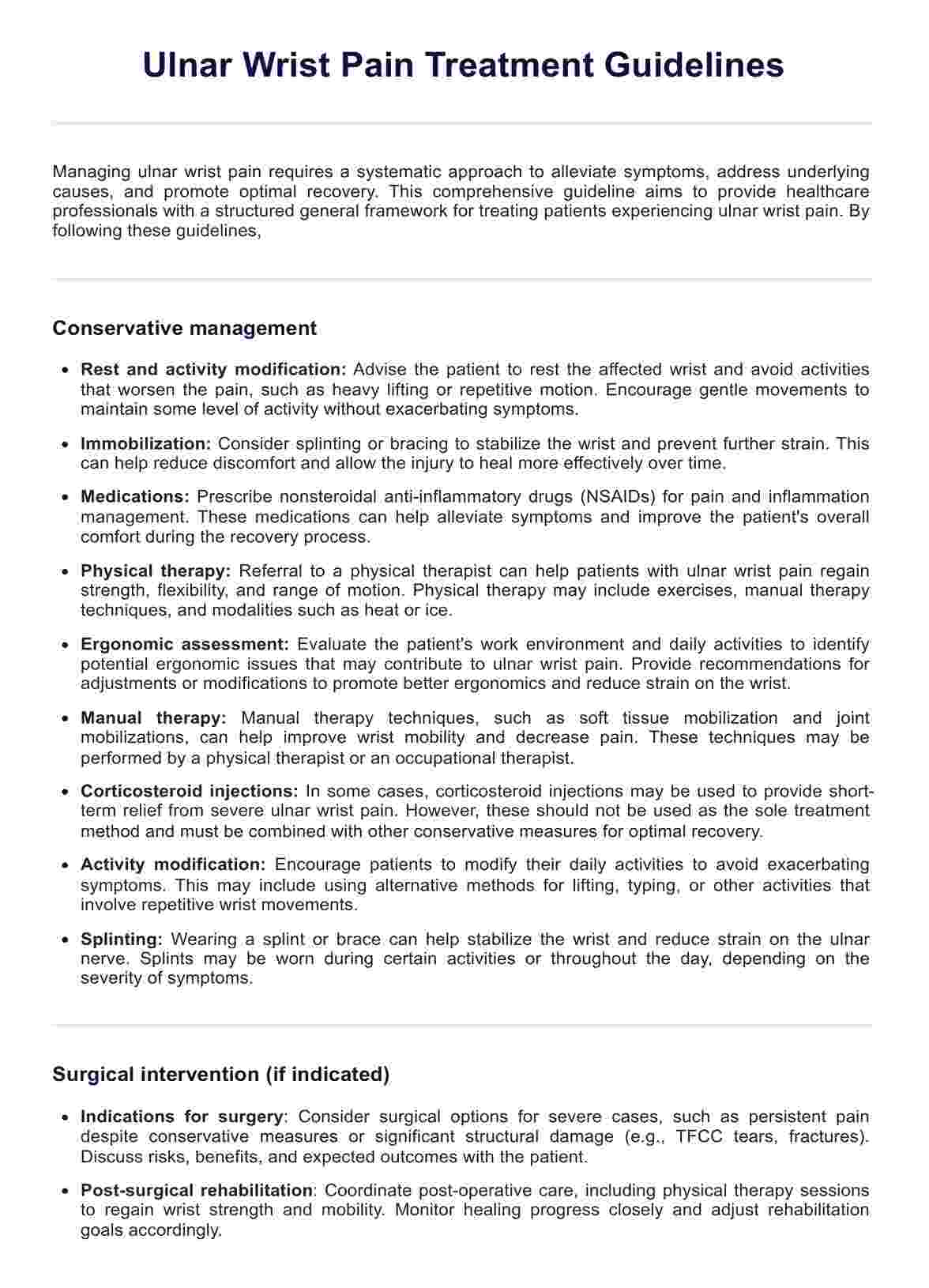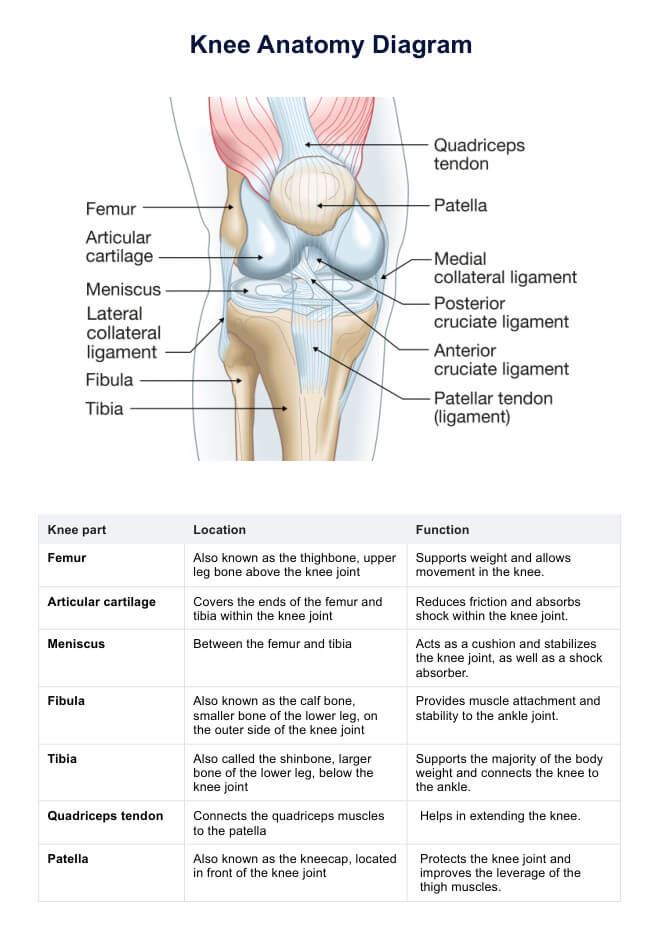Ulnar Wrist Pain Treatment Guidelines
Discover effective treatment guidelines and examples for ulnar wrist pain management. Download Carepatron's free PDF guide to help you understand and address this condition.


What is ulnar wrist pain?
Ulnar wrist pain, often referred to as ulnar-sided wrist pain, specifically affects the side of the wrist where the ulna bone is located. The wrist joint consists of eight carpal bones and two forearm bones—the radius and the ulna. Ulnar wrist pain arises due to various conditions that affect the ulnar-carpal joint or the triangular fibrocartilage complex (TFCC), including injury to bones cartilage, ligaments, or tendons in this area.
Understanding ulnar wrist pain involves recognizing discomfort or inflammation localized on the ulnar side of the wrist. This type of pain can result from repetitive strain, trauma, or degenerative changes affecting the wrist structure. Accurate diagnosis typically involves clinical evaluation and may include imaging studies such as X-rays or MRI scans to assess the extent of the injury or condition causing the pain.
Symptoms of ulnar wrist pain
Ulnar wrist pain can manifest in several ways, depending on the underlying condition and the severity of the injury or inflammation. Recognizing these symptoms is crucial for accurate diagnosis and appropriate treatment. Here are common symptoms associated with ulnar wrist pain:
- Tenderness and soreness on the ulnar side of the wrist
- Pain that worsens with movement of the wrist
- Swelling or inflammation around the ulnar wrist joint
- Difficulty gripping or performing activities that stress the wrist
- Clicking or popping sensations during wrist movement
- Weakness in the wrist or difficulty applying pressure
- Numbness or tingling in the fingers, especially the fourth and fifth digits
These symptoms may vary in intensity and duration, depending on factors such as the cause of the ulnar wrist pain and any underlying conditions affecting the wrist bones, cartilage, ligaments, or tendons. It's important to seek medical evaluation if these symptoms persist or worsen, as early intervention can help prevent further complications and promote recovery.
Causes of ulnar wrist pain
Ulnar wrist pain can stem from various sources related to injury or stress affecting the wrist joint, particularly on the side where the ulna bone is located. Common causes include:
- Injuries to bones and cartilage: Direct trauma or repetitive strain injuries can lead to fractures of the ulna or radius bones, or damage to the cartilage within the wrist joint.
- Ulnar impaction syndrome: This condition occurs when the ulna bone is longer than the radius, causing abnormal contact and wear between bones and soft tissues.
- Triangular fibrocartilage complex injury: The TFCC stabilizes the wrist joint; injury to this complex through sports or repetitive activities can cause ulnar-sided wrist pain.
- Ulnar nerve compression: Compression of the ulnar nerve, which runs from the neck through the wrist, can cause pain, tingling, or numbness in the ulnar side of the wrist.
- Broken wrist: Fractures involving the radius and ulna bones can lead to significant wrist pain and dysfunction.
Understanding the specific cause of ulnar wrist pain is essential for determining the appropriate treatment and management strategies. Medical evaluation and diagnostic imaging may be necessary to identify the underlying condition accurately.
Potential problems this pain may cause
Ulnar wrist pain can lead to several potential problems that impact daily activities and overall wrist function. Persistent pain and discomfort may limit the ability to perform tasks that involve gripping, twisting, or bearing weight on the affected wrist. This can affect productivity at work or participation in recreational activities, leading to reduced quality of life.
In some cases, untreated or improperly managed ulnar wrist pain can contribute to chronic issues such as joint instability or stiffness, which may further restrict mobility and increase the risk of long-term joint damage. Prolonged pain and inflammation may also affect adjacent structures like muscles and tendons, potentially leading to secondary complications such as muscle weakness or tendonitis.
Ulnar Wrist Pain Treatment Guidelines Template
Ulnar Wrist Pain Treatment Guidelines Example
How to use our Ulnar Wrist Pain Treatment Guidelines template
Carepatron's Ulnar Wrist Pain Treatment Guidelines template provides a structured approach for medical professionals to effectively manage and treat ulnar wrist pain. Here are the steps to utilize the template:
Step 1: Download the template
Get a copy of the Ulnar Wrist Pain Treatment Guidelines handout using the link on this page. You can also find it in the Carepatron app.
Step 2: Print or use the digital version
You can choose to print out a physical copy of the template or use it digitally. Both options provide the same comprehensive guide for treating ulnar wrist pain.
Step 3: Familiarize yourself with the template
Take some time to go through the template and understand its structure and content. This will help you navigate through it more efficiently during patient consultations.
Step 4: Gather patient information
Before using the template, gather all necessary information about your patient's condition such as their medical history, lifestyle habits, previous treatments, and current symptoms.
Step 5: Use the handout as a treatment reference
The Ulnar Wrist Pain Treatment Guidelines template provides various treatment options for ulnar wrist pain. Use it as a reference to decide the best course of treatment for your patient.
Benefits of using this treatment guidelines template
Utilizing Carepatron's Ulnar Wrist Pain Treatment Guidelines template offers several advantages for healthcare professionals in managing patients with ulnar wrist pain:
Evidence-based treatment planning
Guided by the template, healthcare providers can develop evidence-based treatment plans tailored to each patient's specific symptoms and needs. This includes outlining interventions such as rest, medication, physical therapy, or surgical options based on the severity and nature of the condition causing ulnar wrist pain.
Enhanced communication and documentation
By using standardized documentation within the template, healthcare teams improve communication across disciplines and settings. Clear, detailed records facilitate continuity of care, enabling seamless transitions between healthcare providers and enhancing overall patient management.
Promotion of patient engagement and education
Carepatron's template includes educational resources that empower patients with information about ulnar wrist pain, treatment options, and self-care strategies. By educating patients and involving them in their treatment plans, healthcare providers foster informed decision-making and improve treatment adherence.
Commonly asked questions
The fastest way to heal ulnar wrist pain involves rest, avoiding activities that aggravate the pain, applying ice to reduce inflammation, and using over-the-counter pain relievers as needed.
In some cases, mild ulnar wrist pain may resolve on its own with rest and conservative treatments. However, persistent or severe pain may require medical intervention for proper diagnosis and treatment.
Wearing a wrist brace can provide support and stability, reducing strain on the affected area and promoting healing. Consult with a healthcare professional to determine the best type of brace and duration of use for your specific condition.
Rehabilitation for ulnar wrist pain typically involves gentle stretching and strengthening exercises prescribed by a physical therapist. Gradual reintroduction of activities and ergonomic adjustments can also help prevent recurrence and promote recovery.







































































































